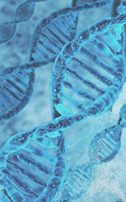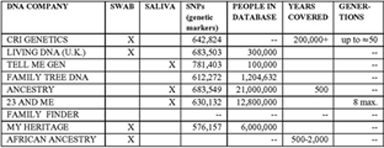DNA Test Results Compared
by Joelle Steele
 You probably already know about genealogy and researching your family history by working backwards to find your grandparents, great-grandparents, great-great-grandparents, etc. DNA can also be used to discover more about your family origins, but on a much broader and less specific scale. As of 2020, approximately 1 out of 5 Americans has taken a DNA test.
You probably already know about genealogy and researching your family history by working backwards to find your grandparents, great-grandparents, great-great-grandparents, etc. DNA can also be used to discover more about your family origins, but on a much broader and less specific scale. As of 2020, approximately 1 out of 5 Americans has taken a DNA test.
DNA tests rely on genetic markers, single nucleotide polymorphisms, otherwise known as SNPS (“snips”). SNPs are genetic variations and are used as markers in genetic testing. Each one represents a difference or variation in a nucleotide that occurs regularly throughout your DNA, generally once every 1,000 nucleotides. Mathematically, that means there are as many as 5 million SNPs in your genome.
In order to recognize a SNP, a variant has to be found in at least 1 percent of the population. As of 2022, it is estimated that there are 600+ million SNPs worldwide. SNPs are found between your genes, and many are used to indicate health issues, such as your predisposition to a certain disease or an inherited disease, etc. Just beware that health issues noted in DNA profiles are very generalized and are not as accurate as the results you would get from having only certain diseases found in your family profiled by your physician.
There are essentially three types of DNA tests:
Y-DNA. Y-chromosones are passed from father to son, so only men are able to trace their patrilineal line with Y-DNA testing. Women don’t have Y-DNA, so a father or brother can usually provide that lineage information. Y-DNA reveals your Y-chromosone haplogroup, which contains your most ancient male ancestors.
mtDNA. Both women and men carry mitochondrial DNA. It is passed on by women to both male and female offspring. This allows you to trace your matrineal line (mother’s line), and reveal your mtDNA haplogroup containing your most ancient female ancestors. Anyone can take an mtDNA test.
Autosomal DNA. These are the most popular DNA tests. They can be taken by men or women because everyone has autosomal chromosones in their DNA. Autosomal chromosones have DNA segments that you share with everyone to whom you’re related, maternally, paternally, directly, or indirectly. Autosomal tests do not provide information on haplogroups, but they provide estimates as to your ethnicity.
When you want a DNA test for a look at your genetic ancestry, look for the following:
1) A timeline to your earliest origins, not just 500 years, not just 8 generations (which would only take you back to about the mid-1700s).
2) A cheek swab rather than saliva. Although it is somewhat rare, saliva can become contaminated by food and other substances.
3) A large database if you are trying to find relatives. In this way, ancestry.com and 23andme.com have the biggest databases. But my experience with 23andme is that the people I’m supposedly related to are not even close to the degree or cousin stated, and of those I contacted, none contacted me back, so I don’t know if I’m really related to them or not.
Below are some of the highest ranked DNA companies, effective January 2023. However, as you can see by this chart, their accuracy rates tell a different story. There are many other DNA companies, and this is just a select few. Most DNA testing relies on the Customized Illumina GSA chip for testing accuracy.

* Companies that only feature autosomal testing do not provide maternal (mtDNA) and paternal (ptDNA).

